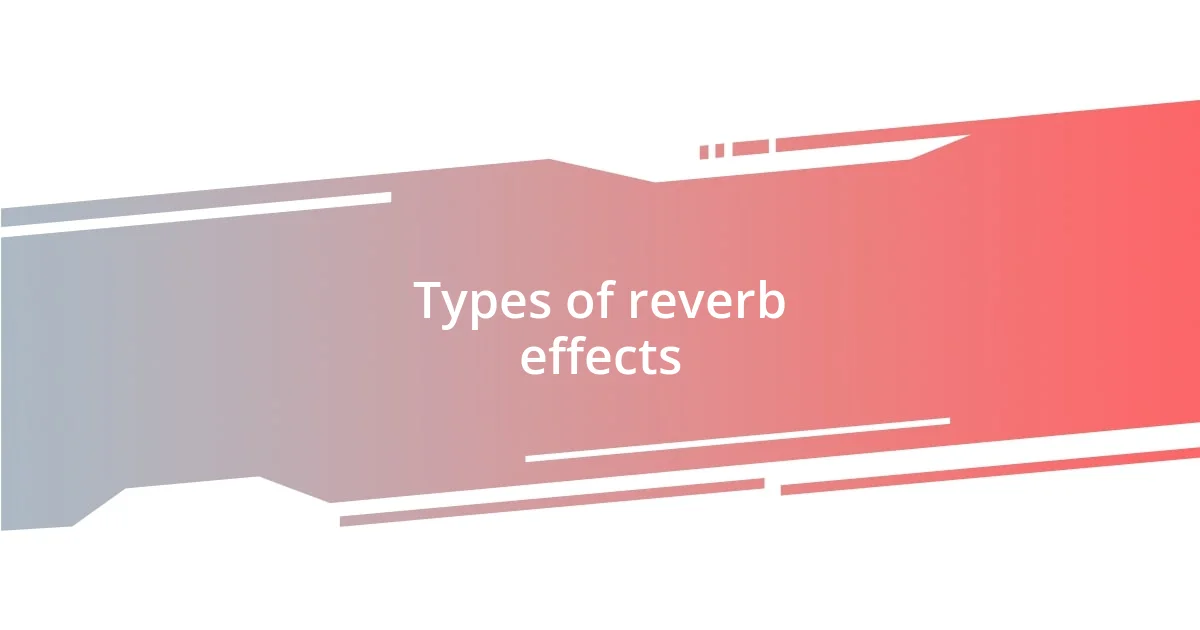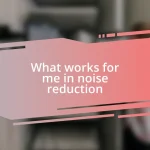Key takeaways:
- Reverb enhances audio by creating early reflections and late reverberation, adding depth and emotional resonance to recordings.
- Different types of reverb effects, like Hall, Room, Plate, Spring, and Chamber, evoke various moods and sonic qualities, influencing listener experience.
- Mindful use of reverb, avoiding overuse and wrong type selection, along with experimenting with settings, is crucial for achieving clarity and emotional impact in music mixes.

Understanding reverb in audio
Reverb, or reverberation, is an essential aspect of audio that replicates how sound behaves in different environments. I remember the first time I experimented with reverb while mixing my own music; the transformation was remarkable. Suddenly, my dry vocals felt more alive, as if they were soaring through a vast cathedral.
Understanding reverb involves recognizing its two main components: early reflections and late reverberation. Have you ever wondered why some recordings feel so full and immersive? It’s those early reflections—tiny echoes that bounce off the walls—adding depth and warmth, making us feel present in the space where the sound was created.
I’ve found that different reverb types can evoke powerful emotions. For instance, using a large hall reverb can bring a sense of grandeur to a vocal track, while a smaller room reverb may create intimacy. This exploration of reverb not only enhances our audio experience but also connects listeners on a deeper emotional level. What type of reverb resonates with you the most?

Types of reverb effects
When diving into the types of reverb effects, I often find myself gravitating toward specific styles that match the mood I’m trying to create. Each type offers a distinct sonic flavor, transforming the audio landscape in unique ways. It’s fascinating to discover how certain reverb types can mimic real spaces or create entirely fantastical environments. When I first experimented with spring reverb, I was captivated by its vintage charm, reminiscent of classic surf rock.
Here are some popular types of reverb effects:
- Hall Reverb: Simulates the sound of a large concert hall, useful for vocals and orchestral sounds.
- Room Reverb: Creates a more intimate sound, ideal for smaller recordings where presence is key.
- Plate Reverb: Uses a metal plate to create a lush, smooth reverb that works wonders on vocals and snares.
- Spring Reverb: Originally found in guitar amplifiers, it adds a metallic, bouncy quality to sound.
- Chamber Reverb: Mimics the sound of a reverberant room, creating a sense of depth without overwhelming the original sound.
By experimenting with these effects, I’ve discovered how reverb can dramatically improve the emotional pull of a piece. For instance, applying chamber reverb to a guitar track made it feel spacious and airy, evoking memories of wandering through ancient stone halls. It’s like each type of reverb has a story to tell.

How reverb affects sound
Reverb plays a crucial role in shaping how we perceive sound. When I add reverb to a track, it’s amazing how it can transform a flat audio experience into something much richer. The way it melds with the original sound gives it a surrounding quality, almost as if the music has stepped into its own environment. Just the other day, I revisited a track I recorded without reverb; it sounded lifeless compared to the lushness I achieved after integrating a chamber reverb. It’s like the sound suddenly found its voice.
One fascinating aspect of reverb is its ability to alter our emotional experience as listeners. I remember working on a ballad where I used a hall reverb—instantly, it filled the song with a sense of longing and nostalgia. Those spacious echoes pulled me back to memories of quiet, expansive places, highlighting the emotional weight of the lyrics. It’s incredible how a simple effect can evoke such vivid imagery and feelings, not just for the artist but also for the audience.
To illustrate different ways reverb impacts sound, here’s a comparison of reverb types and their effects:
| Reverb Type | Effect on Sound |
|---|---|
| Hall Reverb | Creates a large, expansive sound; evokes grandeur and nostalgia. |
| Room Reverb | Adds warmth and intimacy; ideal for vocal tracks. |
| Plate Reverb | Produces a smooth, lush texture; enhances clarity in vocals. |
| Spring Reverb | Offers a bouncy, metallic tone; great for a vintage vibe. |
| Chamber Reverb | Mimics natural rooms; adds depth while maintaining clarity. |

Tips for using reverb
When you’re incorporating reverb, it’s essential to be mindful of how much you’re using. I recall a mixing session where I got a little carried away with hall reverb, thinking it would elevate the track. Instead, it muddied the vocals and made it difficult to understand the lyrics. Less is often more—experimenting with subtle amounts can lead to a more polished and professional sound.
Another tip I find invaluable is to tailor your reverb settings based on the context of the mix. For instance, when I recorded an acoustic guitar, I chose a room reverb that complemented its warmth without overshadowing its natural sound. This choice created an intimate feel that made listeners feel like they were right there in the room with me. Have you ever wondered how different settings can affect the listener’s experience? In my view, it’s like crafting a narrative where each decision leads to an emotional connection.
Finally, always trust your ears. Sometimes, the technicalities can cloud creative instincts. I once spent hours tweaking a snare track’s plate reverb settings, but when I stepped away, I realized that the original sound captured the essence of what I wanted to convey perfectly. If something sounds good to you, that’s what matters most. What’s your unique approach to finding the right reverb for your tracks? Embrace your instincts; they often reveal the sound you didn’t even know you were looking for.

Common mistakes with reverb
One common mistake I see often is the overuse of reverb, leading to a washed-out mix. I remember working on a group project where one member drenched every instrument in a massive hall reverb. While it initially felt immersive, it quickly turned into a sonic blur, and the rhythmic nuances were lost. It’s easy to get caught up in the dreamy soundscapes, but moderation is key for clarity.
Another pitfall is neglecting to consider the type of reverb used for different elements. I once applied a quick plate reverb to a lead guitar, thinking it would add brightness. Instead, it created an oddly metallic effect that overshadowed the warmth intended for that track. Choosing the wrong reverb type can detract from the overall vibe of the composition. Have you ever run into something similar?
Also, forgetting to adjust pre-delay settings can hinder the effectiveness of reverb. I can’t tell you how many times I’ve heard a mix where the reverb tails collided with the initial transient of instruments. Last month, while mixing a drum track, I noticed that adjusting the pre-delay helped clean up the clutter, allowing the kick drum to punch through more effectively. It’s incredible how such a small tweak can make a significant difference in the mix.

Creative applications of reverb
One of my favorite creative applications of reverb is using it to create a sense of space and movement in a track. I remember working on a project where I wanted to evoke the feeling of being in a vast, open field. By layering a long, lush reverb on the backing vocals, I achieved a spacious atmosphere that wrapped around the listener. Isn’t it fascinating how altering a simple parameter can evoke such strong imagery and emotions?
I’ve also experimented with reverb to add an unusual twist to more unexpected elements. For instance, in one song, I took a spoken word sample and drenched it in a cavernous reverb. The result was so surreal that it seemed to transport the listener into a completely different dimension. Have you ever thought about how even non-musical elements can gain depth through reverb? It opens up so many creative possibilities for sound design.
Moreover, reverb can help define a style or genre by setting the mood. I once worked on a lo-fi hip-hop track where I applied a vintage-style spring reverb to the drum samples. The warm, slightly gritty character not only made the beat feel nostalgic but also contributed to the chill vibe that defines the genre. It’s amazing how a thoughtful choice like this can elevate a piece of music; have you tried tailoring reverb to match a specific vibe? Each decision becomes a brushstroke in your sonic canvas.

Best reverb plugins to consider
When it comes to choosing the best reverb plugins, I must emphasize my go-to favorites. Valhalla Room stands out for its versatility and lush, natural-sounding spaces. I remember incorporating it into a mix for a cinematic piece; the way it glided over the strings transformed a simple arrangement into something breathtaking. Have you ever felt a plugin completely change the game for you?
Another plugin I really appreciate is Waves’ H-Reverb. Its unique algorithm allows for creativity in shaping reverb tails and character. I found it particularly useful when mixing a vocal track recently. By tweaking the decay time and adding a touch of modulation, I managed to create an atmospheric effect that perfectly complemented the emotional highs of the performance. It’s amazing how these subtle adjustments have the power to dictate the vibe of a mix.
Lastly, I can’t overlook FabFilter Pro-R, which presents an intuitive interface that invites experimentation. In one session, I was working on a folk track and decided to use Pro-R to add depth to the acoustic guitar. The results were so inviting that it inspired me to keep adjusting until the mix felt warm and enveloping, almost like a hug. Have you ever been surprised by how a reverb can elevate an instrument in such a profound way? It’s a reminder of the plugin’s hidden potential.















